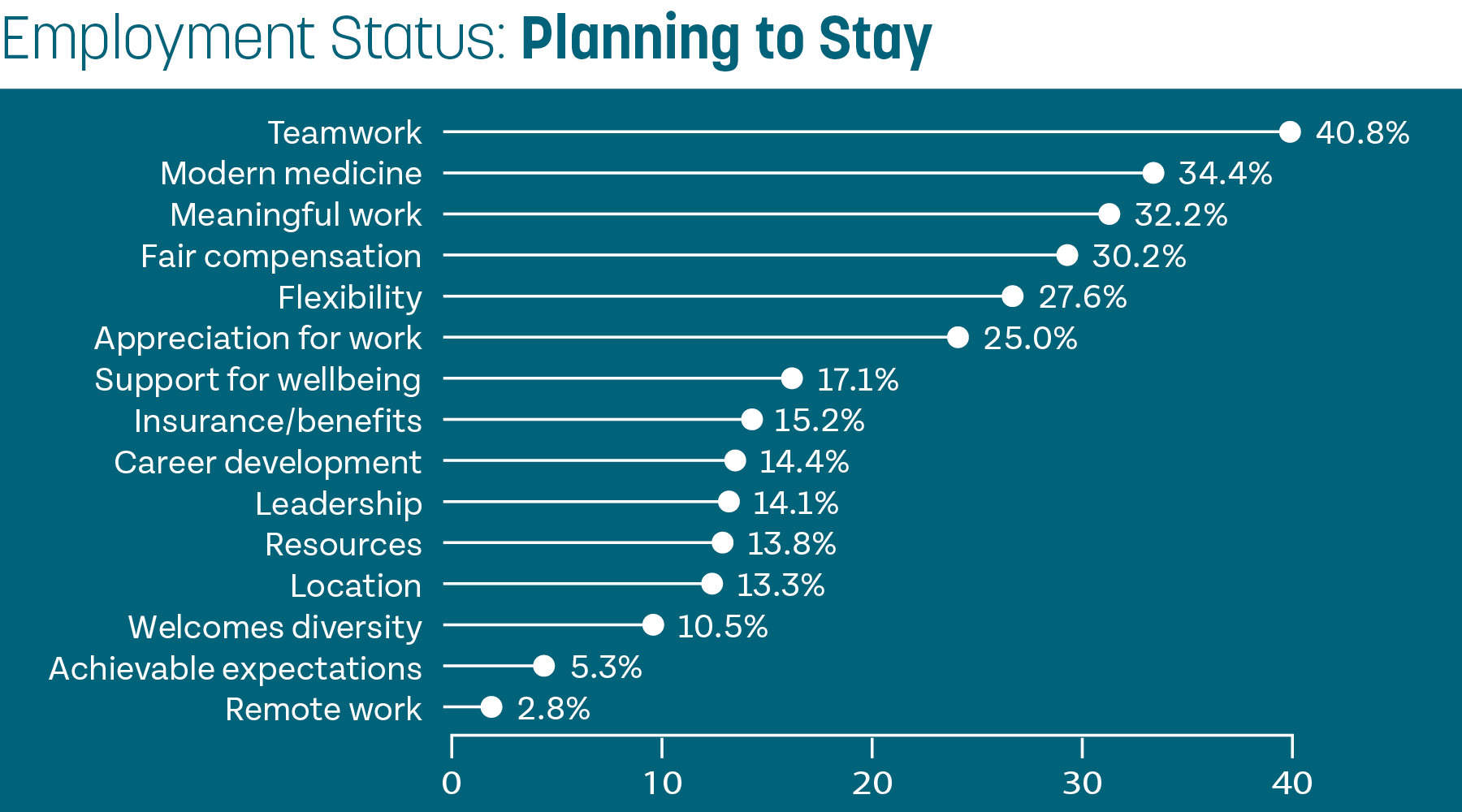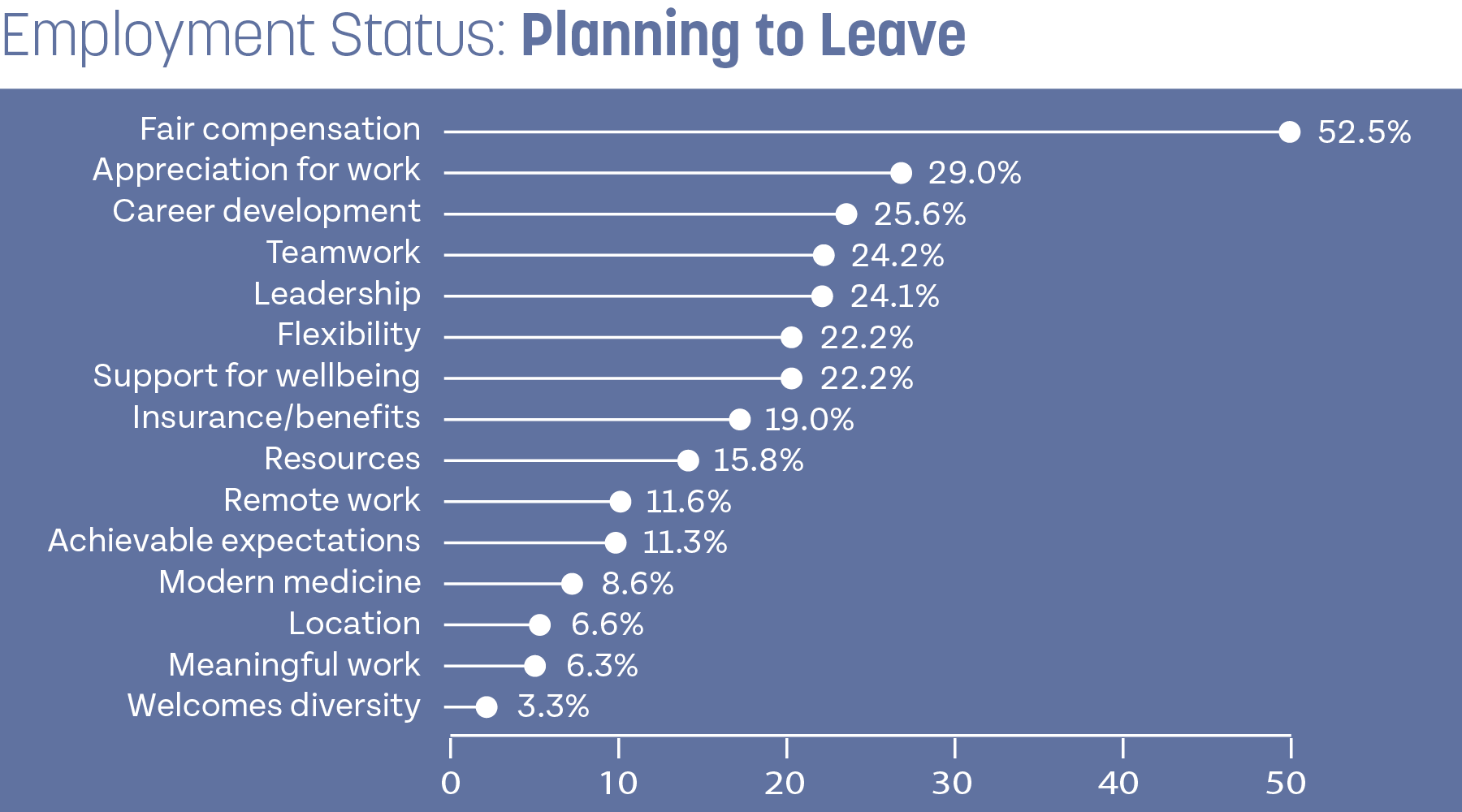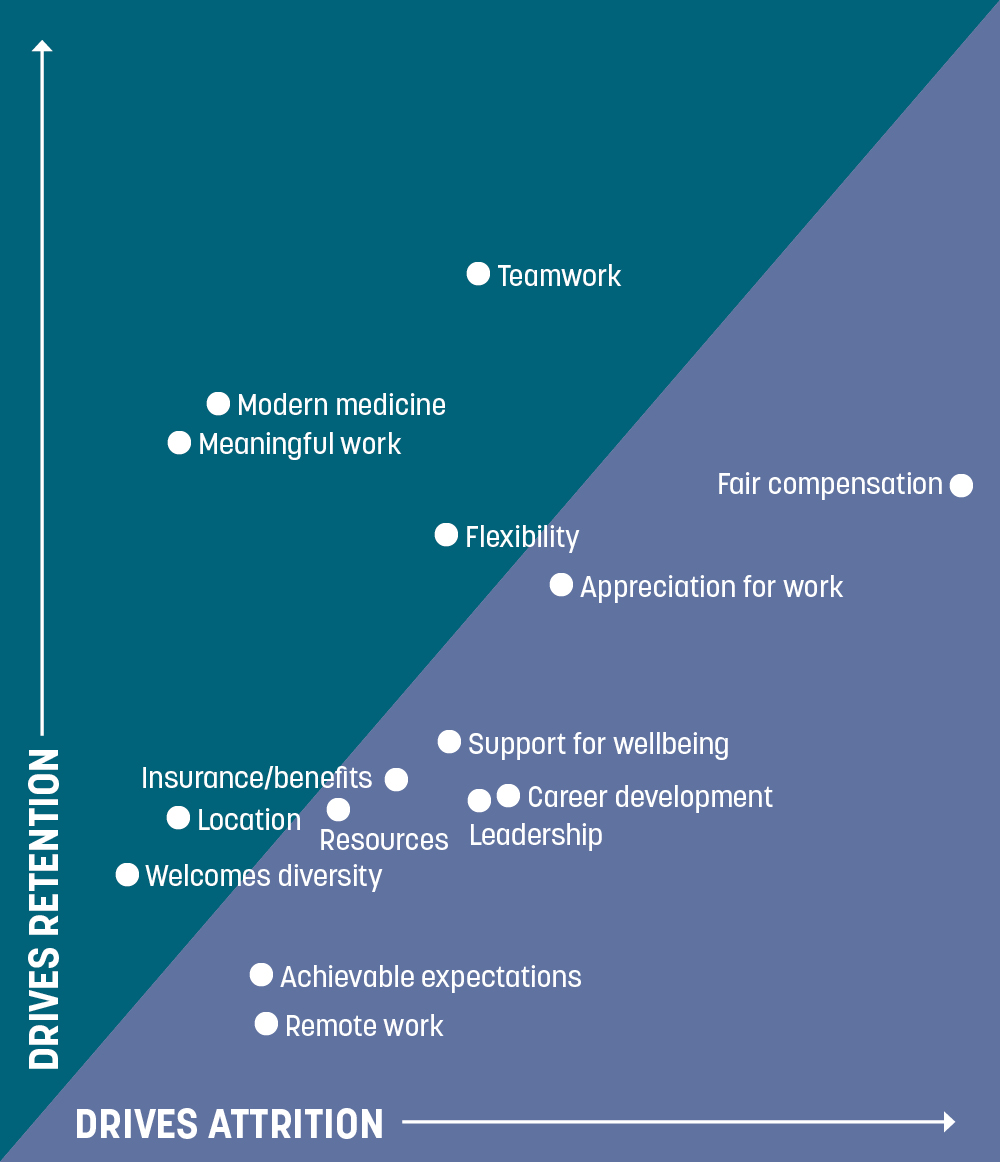Stay, Please
How Do We Keep Good People in Clinical Practice?
By Kristen Green Seymour

“I knew I wanted to be a veterinarian at 10 years old and now, 50 years later, I still enjoy it and find it fulfilling.”
—DVM and practice owner responding to the 2023 AAHA Retention in Veterinary Medicine Survey
That’s the dream, right? Veterinary medicine is a career stemming from passion, and it’s one that requires hard work and dedication to make a reality. After all that, you’d hope the comment above would be the norm.
That makes it even more heartbreaking to learn that, according to the 2023 AAHA Path to Better Retention in Veterinary Medicine Survey (see sidebar: About Our Study), about 30% of veterinary professionals currently in clinical practice plan to leave their jobs. If you’re tuned in at all to the vet med community, this potential attrition rate probably doesn’t surprise you. Staffing shortages abound.
What might come as a surprise is the fact that, in 9 out of 10 cases, once someone has left their job in clinical practice, they say they’re never coming back. And, sorry folks, but it gets worse: Out of that 30% planning to leave their jobs, half plan to leave practice altogether, either to go into another area of vet med or to pursue something else entirely.
In other words, once they’re gone, they’re gone, and frankly, we can’t graduate enough DVMs and credentialed techs to fill the gap they’re leaving behind as demand for veterinary services continues to grow.
The Trouble with Turnover
“Attrition/loss and turnover of nonveterinary staff, particularly nurses, is by far the biggest detractor at my current job and seems somewhat universal to the industry. It negatively impacts all aspects of our work and accelerates the loss of other employees when we are short-staffed.”
—Hospital administrator responding to the 2023 AAHA Retention in Veterinary Medicine Survey
The financial impact of turnover can’t be ignored; a Gallup study estimated that replacing a departing employee comes at a cost of around 1.5 to 2 times their salary—or even more.
But we all know the impact of high turnover is more than financial. The remaining team members often feel a sense of loss or outright turmoil. The practice culture is affected, and, considering it takes an average of more than 15 months to fill a vacant associate DVM role and almost 13 months to fill a credentialed technician role according to a 2022 AAHA industry survey, understaffing is almost unavoidable. This leads to upset clients, a stressed-out team, and burnout . . . and that leads to increased attrition.
Yikes, right? That’s what we thought, too. And that’s exactly why AAHA conducted this survey.
We wanted to understand what factors lead to a veterinary professional’s decision to leave—and, perhaps even more importantly, we wanted to know what matters most to those who plan to remain where they are. What can practices avoid doing to stop driving good employees away? What should they implement if they want to increase their appeal? And how might that change depending on an individual’s role in the clinic?
This survey got a massive response. People had a lot to say—and they wanted to be heard. After months of sorting through the data, consulting with data analysts, and looking at these findings from various angles, we’ve landed on some illuminating findings.
Needs Versus Wants
“Compensation in this industry is a constant source of frustration, especially when the practice is thriving but we don’t see it reflected in our wages. . . . The team and the meaningful work we do is what keeps me in the field, but it would be amazing if the salary was one of the reasons I stick around as well.”
—Practice manager responding to the 2023 AAHA Retention in Veterinary Medicine Survey
We quickly realized that, among the 70% planning to stay where they are, six factors stood out from the rest. While the rank and strength of each factor varied from one role to another, overall, these six factors mattered most to those planning to remain—by quite a lot.
 Respondents could choose up to three factors; therefore, the total percentage here will not add up to 100%.
Respondents could choose up to three factors; therefore, the total percentage here will not add up to 100%.
Staff working as a team, the ability to practice modern and/or sound medicine, doing meaningful work, fair compensation, flexibility in scheduling and/or duties, and feeling like one’s work is appreciated were the top six factors motivating veterinary professionals to stay.
But out of these factors, which are most important? The answer depends on the state of the practice in question. And the state of the practice in question depends on how the employees in said practice feel about their current situation (and/or their employer).
If your practice were a patient, would it be considered an emergency situation? Are employees leaving in droves, and do you need to stop the metaphorical bleeding fast before addressing any other problems? Would it fall into the ADR category? Or would you consider it a well pet check?
Meeting the Basic Needs First
“As a practice manager, I know techs need to make a living wage. I don’t mean $20 an hour, . . . I mean $50k a year and up. Plus, they need benefits. If they wanted to make McDonald’s wages, they would work at McDonald’s.”
—Non-DVM owner responding to the 2023 AAHA Retention in Veterinary Medicine Survey
If your practice is an emergency case, then what we really need to look at are the top drivers of attrition. Why aren’t people willing to stick around?
 This chart clearly tells us the first step to take to stop the bleeding: money.
This chart clearly tells us the first step to take to stop the bleeding: money.
Far and away, the number one factor that respondents planning to leave their jobs named was fair compensation. This was true across the board, but non-DVM roles were almost twice as likely (91%) to name fair compensation as a top factor than their DVM counterparts.
And look at the jump made by appreciation for work. It may not be leaps and bounds above the other factors, but for those planning to stay, it came in sixth place; once they’re planning to leave, it’s number two. When people don’t feel appreciated, it makes them want to leave.
Fair pay and appreciation for work must be considered basic needs. At the very least, employees want to be paid competitively and be shown appreciation for their work. If those two needs aren’t met, any effort you make toward the other factors (team building, job flexibility, etc.) are unlikely to be enough.
Now, we acknowledge that increasing wages can be a challenge, but remember how much Gallup estimates the replacement cost of an employee to be? Paying quality employees competitively will likely be easier on the budget than replacing them. Plus, when it comes to technicians, what they want may not actually be that far off what you’re currently paying them (see sidebar: The True Value of Vet Techs).
Giving the People What They Want
“We are a true team family. It’s a real pleasure to be a part of that.”
—Medical director responding to the 2023 AAHA Retention in Veterinary Medicine Survey
Now, meeting those basic needs should keep people from sprinting for the door. But that’s not the same thing as inspiring them to stay, right? That’s where our wants—or top drivers of retention—become more crucial.

If your practice were a patient, would it be considered an emergency situation? Are employees leaving in droves, and do you need to stop the metaphorical bleeding fast before addressing any other problems?
The chart above takes into account each factor’s strength as a driver of retention and as a driver of attrition. The higher an item is toward the top, the stronger it is as a retention factor; the farther it lands to the right, the more it impacts attrition. So, what are the biggest factors causing people to leave their jobs in practice? Their needs (fair pay and appreciation for work) aren’t being met. A lack of the other four factors—teamwork, modern medicine, meaningful work, and flexibility—is less likely to be the reason someone leaves, but when a practice gets this right, that’s when people stick around for the long haul.
That said, there’s a big difference between understanding what inspires people to stay and actually making lasting change in a practice to prioritize these key factors. And, it’s important to remember that there’s no one-size-fits-all way to implement these retention drivers. We can provide all the data in the world, but it’s up to each individual practice to make the necessary changes.
|
|
The Journey to 90%
“I finally work with a practice that doesn’t burn through their vets and staff. Each team member is respected and understands their job. . . . Compensation is more than I’ve ever had (first time with benefits!), and I am paid more for much less work. The last isn’t a reason I joined them but is a perk. Owner and management back vets up if there are client issues. I’ve been at my current job for three years (was at my previous for nine years) and have zero plans to leave unless family requires it.”
—Associate DVM at 24/7 mobile practice responding to the 2023 AAHA Retention in Veterinary Medicine Survey
Our hope is that, by sharing these findings (and many more, which you can find in our latest white paper at aaha.org/research), veterinary practices will easily be able to identify the areas where they have room to improve. In fact, our overarching goal is to help the veterinary medicine community as a whole reach 90% retention—but that journey begins with each practice taking its first step.
For many practices, that may be hiring a consultant to do a compensation audit in order to assess how their compensation package stacks up to the competition. For others who are confident they already offer fair pay, looking for ways to show employees appreciation for their work will take precedence—and a pizza party won’t cut it. Food is fine, of course, but true appreciation needs to be woven into the very fabric of a practice’s culture, and everyone from management to colleagues to clients should be given the opportunity to express appreciation for any member of the team.
For those practices already meeting the basic needs, one of the keys to successfully implementing the remaining four factors is to take a critical look at your current team—collectively, as specific roles, and as individual people, too. Are there any roles with higher turnover than others, or roles from which you’re hearing the same complaint repeatedly? Remember that based on the survey, while these factors mattered to everyone, the strength of each factor differed by role.
Take, for example, the ability to practice modern and/or sound medicine. Unsurprisingly, this is of the utmost importance for our medical roles; in fact, it was at the very top of the list for associate DVMs and credentialed technicians staying in their jobs. If you’re having a hard time keeping people in those roles and you’ve gotten comments from employees about outdated equipment or methods, this would be a wise place to invest.
If, on the other hand, your attrition challenge is with your CSRs or veterinary assistants, new lab equipment might not do much. Instead, helping them understand that their work is meaningful can go a long way. Do they see how their work contributes to the overall mission of your practice? Do they understand how their duties make a real difference in patient outcomes and client experience? Every phone call they make, every crate they clean, every client they spend time getting to know has real meaning.
In fact, the whole team should understand how each and every role contributes in a meaningful way to a larger goal, whether that’s providing exceptional patient care, increasing client compliance, or educating new pet parents about the value of regular veterinary care.
While there’s no magic pill to miraculously improve retention in a practice, understanding these six factors—and how they relate to your practice and team—is a solid place to begin your journey.
|
|
 |
Kristen Green Seymour is a copywriter at AAHA, and when she's not writing about how veterinary practices can improve staff retention, you can often find her snuggling with her senior pets or doing something fun and active outdoors. |
Photo credits: ©AAHA/Robin Taylor





